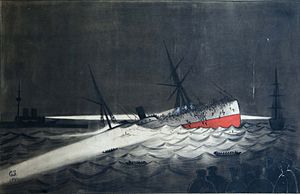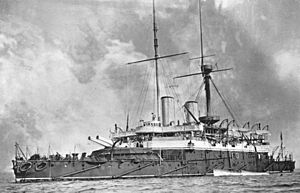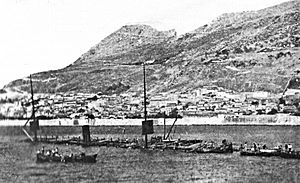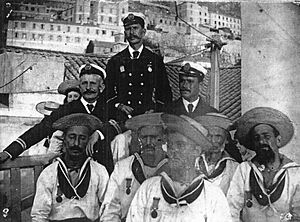SS Utopia facts for kids
class="infobox " style="float: right; clear: right; width: 315px; border-spacing: 2px; text-align: left; font-size: 90%;"
| colspan="2" style="text-align: center; font-size: 90%; line-height: 1.5em;" | 
|} The SS Utopia was a large passenger steamship. It was built in 1874 in Glasgow, Scotland. For many years, Utopia sailed across the Atlantic Ocean. It carried people between Europe and New York City.
The ship was owned by the Anchor Line. At first, it sailed from Glasgow to New York and Bombay. Later, it sailed from London to New York. After 1882, Utopia mainly carried Italian immigrants to the United States.
On March 17, 1891, a terrible accident happened. Utopia crashed into a British battleship called HMS Anson. This happened in the Bay of Gibraltar. Utopia sank very quickly, in just 20 minutes. Many lives were lost, including 562 passengers and crew from Utopia. Two rescuers also died.
Contents
| History | |
|---|---|
| Name | SS Utopia |
| Operator | Anchor Line |
| Route | Transatlantic |
| Builder | Robert Duncan & Co., Glasgow |
| Launched | 14 February 1874 |
| Maiden voyage | 23 May 1874 |
| Refit | 1890–91 |
| Fate | Sank in Gibraltar on 17 March 1891. Scrapped in 1900. |
| General characteristics | |
| Tonnage | 2,371 GRT |
| Length | 350 ft (110 m) |
| Beam | 35 ft (11 m) |
| Propulsion | Triple expansion steam engine |
| Speed | 13 knots (24 km/h) |
The Ship's Early Journeys
Utopia was built by Robert Duncan & Co. in Glasgow. It was made for the Anchor Line. Utopia was similar to two other ships, Elysia and Alsatia.
The ship was designed to carry many passengers. It had room for 120 first-class passengers. There were also 60 second-class passengers. Plus, it could hold 600 third-class passengers. These third-class passengers stayed in a part of the ship called steerage.
Utopia was launched on February 14, 1874. Its first trip to New York City was on May 23, 1874. After 12 trips between Glasgow and New York, it started sailing to Bombay. In 1876, Utopia began sailing from London to New York.
In 1878, Utopia accidentally hit and sank a German ship called Helios. Luckily, Utopia was able to rescue all of Helios' crew. Utopia completed 40 round trips on the London to New York route.
Carrying Immigrants
In 1882, Utopia moved to the Mediterranean Sea. It then regularly carried Italian immigrants to the United States. To make more space for these passengers, the ship was changed.
In 1890–91, Utopia was updated with a new engine. The first-class area was made smaller. The second-class area was removed completely. The number of beds for third-class passengers grew to 900. This allowed many more immigrants to travel.
The Sinking of Utopia
On February 25, 1891, Utopia began a new journey. It left Trieste and was headed for New York City. The ship made stops in Naples, Genoa, and Gibraltar.
There were 880 people on board. This included 59 crew members and 815 third-class passengers. There were also 3 first-class passengers and 3 people hiding on the ship. Among the passengers were 85 women and 67 children.
Captain John McKeague was in charge of Utopia. He later stated that one of the ship's seven lifeboats was missing. The lifeboats could hold about 460 people in good weather.
The Collision
Utopia arrived in Gibraltar on the afternoon of March 17. Captain McKeague tried to steer the ship to its usual spot. But he saw that two battleships were already there. These were HMS Anson and HMS Rodney.
Captain McKeague later said a searchlight from Anson temporarily blinded him. When he could see clearly, he realized the harbor was full of ships. He thought Anson was farther away than it was. He tried to steer Utopia in front of Anson's front end.
Suddenly, a strong wind and current pushed Utopia. It crashed into Ansons front part. Ansons ram (a strong point on its bow) tore a large hole in Utopias side. The hole was about 5 meters (16 feet) wide. Water quickly rushed into Utopias lower decks. The crash happened at 6:36 p.m.
Ship Goes Down
Captain McKeague first thought about steering the ship onto the shore. But Utopia quickly lost engine power. The engineers had turned off the engines to stop a steam explosion.
Captain McKeague ordered everyone to leave the ship. He told the crew to lower the lifeboats. But Utopia suddenly tilted very sharply, about 70 degrees. This caused the lifeboats to be crushed and sink.
The people who survived held onto the side of Utopia. Hundreds of others were stuck inside the lower decks. Just 20 minutes after the crash, Utopia sank. It went down to a depth of 17 meters (56 feet). The ship's masts stuck out above the water. These became a last place for survivors to hold on.
Rescue Efforts
Other ships nearby quickly sent help. Anson, the Swedish ship Freja, and others sent rescue crews. But the weather was bad, with strong winds and rain. A strong current also made rescue difficult. Rescuers struggled to see people in the water.
Two sailors from HMS Immortalité, James Croton and George Hales, drowned. Their boat drifted onto rocks while they were trying to save people. Rescue efforts continued until 11 p.m.
Out of 880 people on Utopia, only 318 survived. This included 290 third-class passengers, 2 first-class passengers, 3 Italian helpers, and 23 crew members. Sadly, 562 people from Utopia died or were missing.
After the Disaster
The two brave sailors who died, Croton and Hales, were buried with military honors. This happened on March 19. The first group of Utopia victims were buried on March 20. There were 28 adults and 3 children.
Divers explored the sunken ship. They reported that the inside of Utopia was full of bodies. Many people were stuck together. It was very hard to separate them. Hundreds of bodies remained trapped in the ship's lower decks.
Captain McKeague was questioned about the accident. He was found responsible for serious mistakes. The court said he tried to enter the harbor without checking for other ships. They also said he tried to turn his ship in front of Anson.
The Wreck's Fate
After the accident, the port authority made the Anchor Line light up the wreck. Lights were placed on the masts of Utopia that stuck out of the water. But even with the lights, another ship, SS Primula, hit the wreck. The crew of Primula said they saw the lights but not the ship itself.
The wreck of Utopia was finally pulled up in July 1892. It was taken back to Scotland. The owners decided not to fix the ship. It was left to rust in the River Clyde. The old ship was finally taken apart for scrap metal in 1900.
See also
- The sinking of HMS Victoria




